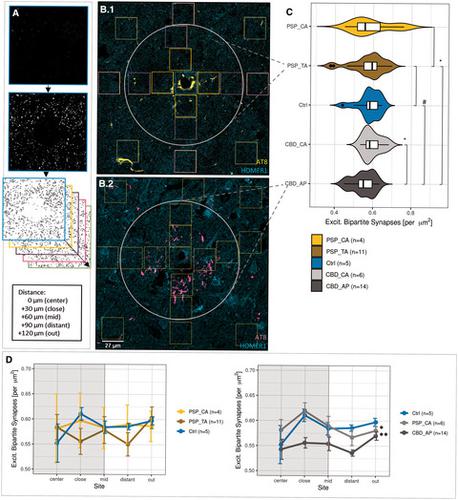当前位置:
X-MOL 学术
›
Brain Pathol.
›
论文详情
Our official English website, www.x-mol.net, welcomes your
feedback! (Note: you will need to create a separate account there.)
Contribution of the astrocytic tau pathology to synapse loss in progressive supranuclear palsy and corticobasal degeneration
Brain Pathology ( IF 5.8 ) Pub Date : 2020-10-22 , DOI: 10.1111/bpa.12914 Nils Briel 1, 2, 3 , Katrin Pratsch 1, 2 , Sigrun Roeber 2 , Thomas Arzberger 1, 2, 4 , Jochen Herms 1, 2, 5
Brain Pathology ( IF 5.8 ) Pub Date : 2020-10-22 , DOI: 10.1111/bpa.12914 Nils Briel 1, 2, 3 , Katrin Pratsch 1, 2 , Sigrun Roeber 2 , Thomas Arzberger 1, 2, 4 , Jochen Herms 1, 2, 5
Affiliation

|
Primary 4-repeat tauopathies with frontotemporal lobar degeneration (FTLD) like Progressive Supranuclear Palsy (PSP) or Corticobasal Degeneration (CBD) show diverse cellular pathology in various brain regions. Besides shared characteristics of neuronal and oligodendroglial cytoplasmic inclusions of accumulated hyperphosphorylated tau protein (pTau), astrocytes in PSP and CBD contain pathognomonic pTau aggregates — hence, lending the designation tufted astrocytes (TA) or astrocytic plaques (AP), respectively. pTau toxicity is most commonly assigned to neurons, whereas the implications of astrocytic pTau for maintaining neurotransmission within the tripartite synapse of human brains is not well understood. We performed immunofluorescent synapse labeling and automated puncta quantification in the medial frontal gyrus (MFG) and striatal regions from PSP and CBD postmortem samples to capture morphometric synaptic alterations. This approach indicated general synaptic losses of both, excitatory and inhibitory bipartite synapses in the frontal cortex of PSP cases, whereas in CBD lower synapse densities were only related to astrocytic plaques. In contrast to tufted astrocytes in PSP, affected astrocytes in CBD could not preserve synaptic integrity within their spatial domains, when compared to non-affected internal astrocytes or astrocytes in healthy controls. These findings suggest a pTau pathology-associated role of astrocytes in maintaining connections within neuronal circuits, considered as the microscopic substrate of cognitive dysfunction in CBD. By contrasting astrocytic-synaptic associations in both diseases, we hereby highlight astrocytic pTau as an important subject of prospective research and as a potential cellular target for therapeutic approaches in the primary tauopathies PSP and CBD.
中文翻译:

星形细胞 tau 病理学对进行性核上性麻痹和皮质基底节变性突触丧失的贡献
具有额颞叶变性 (FTLD) 的原发性 4 重复 tau 蛋白病,如进行性核上性麻痹 (PSP) 或皮质基底节变性 (CBD),在不同的大脑区域显示出不同的细胞病理学。除了积累的过度磷酸化 tau 蛋白 (pTau) 的神经元和少突胶质细胞胞质内含物的共同特征外,PSP 和 CBD 中的星形胶质细胞还含有典型的 pTau 聚集体——因此,分别称为簇状星形胶质细胞 (TA) 或星形胶质细胞斑块 (AP)。pTau 毒性最常分配给神经元,而星形细胞 pTau 对维持人脑三联突触内的神经传递的影响尚不清楚。我们在 PSP 和 CBD 死后样本中的额内侧回 (MFG) 和纹状体区域进行免疫荧光突触标记和自动泪点定量,以捕获形态测量突触的变化。这种方法表明 PSP 病例额叶皮层中兴奋性和抑制性二分突触的一般突触损失,而在 CBD 中,较低的突触密度仅与星形胶质细胞斑块有关。与 PSP 中的簇状星形胶质细胞相比,与健康对照中未受影响的内部星形胶质细胞或星形胶质细胞相比,CBD 中受影响的星形胶质细胞无法在其空间域内保持突触完整性。这些发现表明星形胶质细胞在维持神经元回路内的连接中具有 pTau 病理学相关作用,被认为是 CBD 认知功能障碍的微观底物。
更新日期:2020-10-22
中文翻译:

星形细胞 tau 病理学对进行性核上性麻痹和皮质基底节变性突触丧失的贡献
具有额颞叶变性 (FTLD) 的原发性 4 重复 tau 蛋白病,如进行性核上性麻痹 (PSP) 或皮质基底节变性 (CBD),在不同的大脑区域显示出不同的细胞病理学。除了积累的过度磷酸化 tau 蛋白 (pTau) 的神经元和少突胶质细胞胞质内含物的共同特征外,PSP 和 CBD 中的星形胶质细胞还含有典型的 pTau 聚集体——因此,分别称为簇状星形胶质细胞 (TA) 或星形胶质细胞斑块 (AP)。pTau 毒性最常分配给神经元,而星形细胞 pTau 对维持人脑三联突触内的神经传递的影响尚不清楚。我们在 PSP 和 CBD 死后样本中的额内侧回 (MFG) 和纹状体区域进行免疫荧光突触标记和自动泪点定量,以捕获形态测量突触的变化。这种方法表明 PSP 病例额叶皮层中兴奋性和抑制性二分突触的一般突触损失,而在 CBD 中,较低的突触密度仅与星形胶质细胞斑块有关。与 PSP 中的簇状星形胶质细胞相比,与健康对照中未受影响的内部星形胶质细胞或星形胶质细胞相比,CBD 中受影响的星形胶质细胞无法在其空间域内保持突触完整性。这些发现表明星形胶质细胞在维持神经元回路内的连接中具有 pTau 病理学相关作用,被认为是 CBD 认知功能障碍的微观底物。











































 京公网安备 11010802027423号
京公网安备 11010802027423号